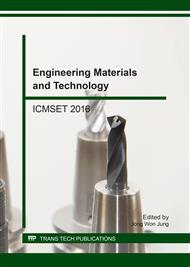[1]
C. Chen, X. J. Zhang, Y. Wang, L. X. Zhu, J. Liu, Waste water disinfection during SARS epdemic for microbiological and toxicological control, Biomed. Environ. Sci. 19(3) (2006) 173-178.
Google Scholar
[2]
Q. Y. Ma, D. Z. Tian, T. Zhang, Selection and rational use of disinfectants used in animal epidemic prevention, J. Anim. Sci. Vet. Med. 34(6) (2015) 106-107.
Google Scholar
[3]
C. Step Hanie, S. Brenton, P. Martin, Efficacy of common disinfectant/cleaning agents in inactivating murine norovirus and feline calicivirus as surrogate viruses for human norovirus, Am. J. Infect. Control. 43(11) (2015) 1208-1212.
DOI: 10.1016/j.ajic.2015.06.021
Google Scholar
[4]
H. W. Yu, S. G. Oh, I. S. Kim, I. Pepper, S. Snyder, A. Jang, Formation and speciation of haloacetic acids in seawater desalination using chlorine dioxide as disinfectant, J. Ind. Eng. Chem. 26 (2015) 193-201.
DOI: 10.1016/j.jiec.2014.10.046
Google Scholar
[5]
S. Sorlini, C. Collvignarelli, Trihalomethane formation during chemical oxidation with chlorine, chlorine dioxide and ozone of ten Italian natural waters, Desalination 176(1-3) (2005) 103-111.
DOI: 10.1016/j.desal.2004.10.022
Google Scholar
[6]
Y. L. Wang, H. J. Liu, G. G. Liu, Y. H. Xie, X. Y. Liu, Kinetics for diclofenac degradation by chlorine dioxide in aqueous media Influences of natural organic matter additives, J. Taiwan Inst. Chem. Eng. 56 (2015) 131-137.
DOI: 10.1016/j.jtice.2015.04.015
Google Scholar
[7]
L. Xu, G. Cseko, A. Petz, A.K. Horvath. Kinetics and mechanism of the oxidation of pentathionate ion by chlorine dioxide in a slightly acidic medium, J. Phys. Chem. A 118 (2014) 1293-1299.
DOI: 10.1021/jp412333e
Google Scholar
[8]
R. S. Eddy, A. P. Joyce, S. Roberts, T. B. Buxton, F. Liewehr. An invitro evaluation of the antibacterial efficacy of chlorine dioxide on E. faecalis in bovine incisors, J. Endodont. 31 (2005) 672-675.
DOI: 10.1097/01.don.0000155223.87616.02
Google Scholar
[9]
I. Colgecen, M. S. Aday, The efficacy of the combined use of chlorine dioxide and passive modified atmosphere packaging on sweet cherry quality, Postharvest Biol. Tec. 109 (2015) 10-19.
DOI: 10.1016/j.postharvbio.2015.05.016
Google Scholar
[10]
Y. Han, T. L. Selby, K. K. Schneider, P. E. Nelson, R. H. Linton, Decontaminition of strawberries using batch and continuous chlorine dioxide gas treatments, J. Food Prot. 67(11) (2004) 2450-2455.
DOI: 10.4315/0362-028x-67.11.2450
Google Scholar
[11]
D. J. Smith, W. Ernst, G. R. Herges, Chloroxyanion Residues in Cantaloupe and Tomatoes after Chlorine Dioxide Gas Sanitation, J. Agr. Food Chem. 63(43) (2015) 9640-9649.
DOI: 10.1021/acs.jafc.5b04153
Google Scholar
[12]
L. Maranda, A. M. Cox, R. G. Campbell, D. C. Smith, Chlorine dioxide as a treatment for ballast water to control invasive species: Shipboard testing, Mar. Pollut. Bull. 75 (2013) 76-89.
DOI: 10.1016/j.marpolbul.2013.08.002
Google Scholar
[13]
F. X. Xu, S. H. Wang, J. Xu, S. Y. Liu, G. D. Li, Effects of combined aqueous chlorine dioxide and UV-C on shelf-life quality of blueberries, Postharvest Biol. Tec. 117 (2016) 125-131.
DOI: 10.1016/j.postharvbio.2016.01.012
Google Scholar
[14]
X. Q. Zhou, J. Y. Zhao, Z. F. Li, J. R. Lan, Y. J. Li, X. Yang, D. L. Wang, Influence of ultrasound enhancement on chlorine dioxide consumption and disinfection by products formation for secondary effluents disinfection, Ultrason. Sonochem. 28 (2016).
DOI: 10.1016/j.ultsonch.2015.08.017
Google Scholar
[15]
T. Sigstam, A. Rohatschek, Q. X. Zhong, M. Brennecke, T. Kohn, On the cause of the tailing phenomenon during virus disinfection by chlorine dioxide, Water Res. 48 (2014) 82-89.
DOI: 10.1016/j.watres.2013.09.023
Google Scholar
[16]
S. Sorlini, F. Gialdini, M. Biasibetti, C. Collivignarelli, Influence of drinking water treatments on chlorine dioxide consumption and chlorite/chlorate formation, Water Res. 54 (2014) 44-52.
DOI: 10.1016/j.watres.2014.01.038
Google Scholar


